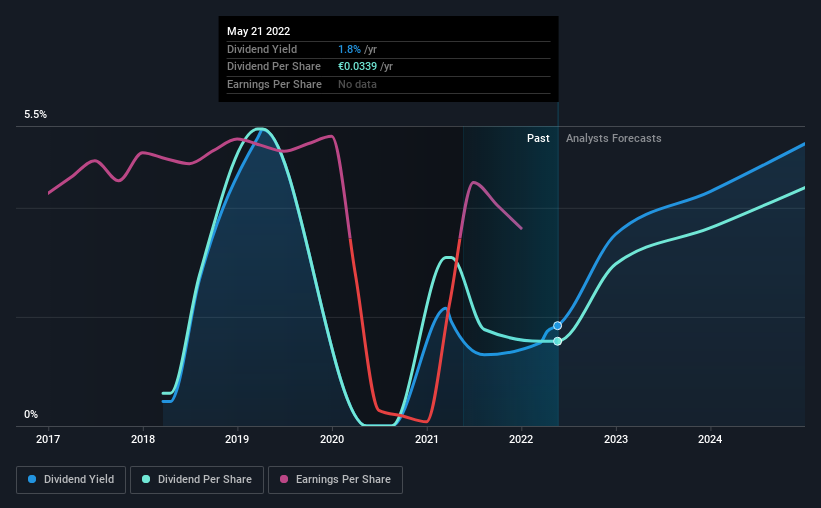Why It Might Not Make Sense To Buy TI Fluid Systems plc (LON:TIFS) For Its Upcoming Dividend
Readers hoping to buy TI Fluid Systems plc (LON:TIFS) for its dividend will need to make their move shortly, as the stock is about to trade ex-dividend. The ex-dividend date is one business day before a company's record date, which is the date on which the company determines which shareholders are entitled to receive a dividend. The ex-dividend date is important as the process of settlement involves two full business days. So if you miss that date, you would not show up on the company's books on the record date. Thus, you can purchase TI Fluid Systems' shares before the 26th of May in order to receive the dividend, which the company will pay on the 23rd of June.
The company's next dividend payment will be €0.015 per share, on the back of last year when the company paid a total of €0.034 to shareholders. Calculating the last year's worth of payments shows that TI Fluid Systems has a trailing yield of 1.8% on the current share price of £1.56. Dividends are a major contributor to investment returns for long term holders, but only if the dividend continues to be paid. So we need to check whether the dividend payments are covered, and if earnings are growing.
Check out our latest analysis for TI Fluid Systems
Dividends are typically paid from company earnings. If a company pays more in dividends than it earned in profit, then the dividend could be unsustainable. TI Fluid Systems distributed an unsustainably high 123% of its profit as dividends to shareholders last year. Without extenuating circumstances, we'd consider the dividend at risk of a cut. That said, even highly profitable companies sometimes might not generate enough cash to pay the dividend, which is why we should always check if the dividend is covered by cash flow. Fortunately, it paid out only 49% of its free cash flow in the past year.
It's disappointing to see that the dividend was not covered by profits, but cash is more important from a dividend sustainability perspective, and TI Fluid Systems fortunately did generate enough cash to fund its dividend. If executives were to continue paying more in dividends than the company reported in profits, we'd view this as a warning sign. Very few companies are able to sustainably pay dividends larger than their reported earnings.
Click here to see the company's payout ratio, plus analyst estimates of its future dividends.
Have Earnings And Dividends Been Growing?
Businesses with shrinking earnings are tricky from a dividend perspective. If earnings fall far enough, the company could be forced to cut its dividend. Readers will understand then, why we're concerned to see TI Fluid Systems's earnings per share have dropped 25% a year over the past five years. Ultimately, when earnings per share decline, the size of the pie from which dividends can be paid, shrinks.
The main way most investors will assess a company's dividend prospects is by checking the historical rate of dividend growth. In the past four years, TI Fluid Systems has increased its dividend at approximately 27% a year on average. The only way to pay higher dividends when earnings are shrinking is either to pay out a larger percentage of profits, spend cash from the balance sheet, or borrow the money. TI Fluid Systems is already paying out 123% of its profits, and with shrinking earnings we think it's unlikely that this dividend will grow quickly in the future.
To Sum It Up
Should investors buy TI Fluid Systems for the upcoming dividend? It's not a great combination to see a company with earnings in decline and paying out 123% of its profits, which could imply the dividend may be at risk of being cut in the future. However, the cash payout ratio was much lower - good news from a dividend perspective - which makes us wonder why there is such a mis-match between income and cashflow. It's not that we think TI Fluid Systems is a bad company, but these characteristics don't generally lead to outstanding dividend performance.
With that in mind though, if the poor dividend characteristics of TI Fluid Systems don't faze you, it's worth being mindful of the risks involved with this business. To help with this, we've discovered 3 warning signs for TI Fluid Systems (1 is a bit unpleasant!) that you ought to be aware of before buying the shares.
If you're in the market for strong dividend payers, we recommend checking our selection of top dividend stocks.
Have feedback on this article? Concerned about the content? Get in touch with us directly. Alternatively, email editorial-team (at) simplywallst.com.
This article by Simply Wall St is general in nature. We provide commentary based on historical data and analyst forecasts only using an unbiased methodology and our articles are not intended to be financial advice. It does not constitute a recommendation to buy or sell any stock, and does not take account of your objectives, or your financial situation. We aim to bring you long-term focused analysis driven by fundamental data. Note that our analysis may not factor in the latest price-sensitive company announcements or qualitative material. Simply Wall St has no position in any stocks mentioned.

 Yahoo Finance
Yahoo Finance 
